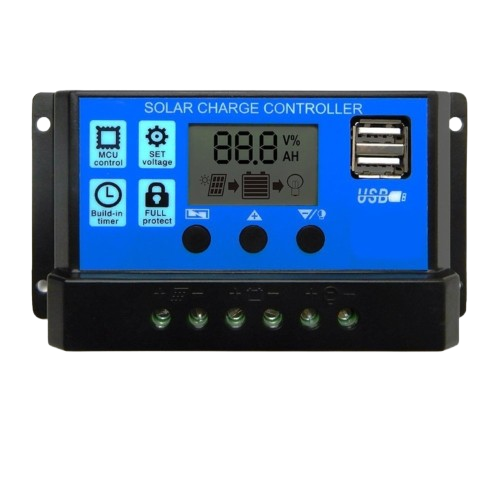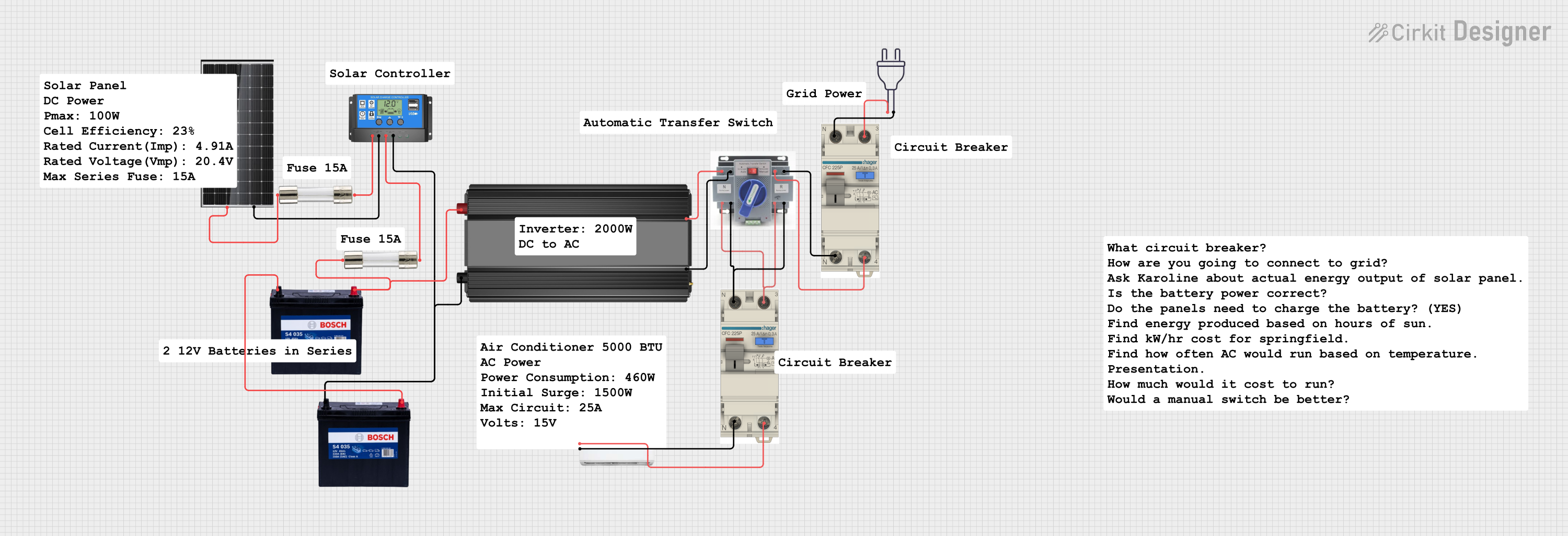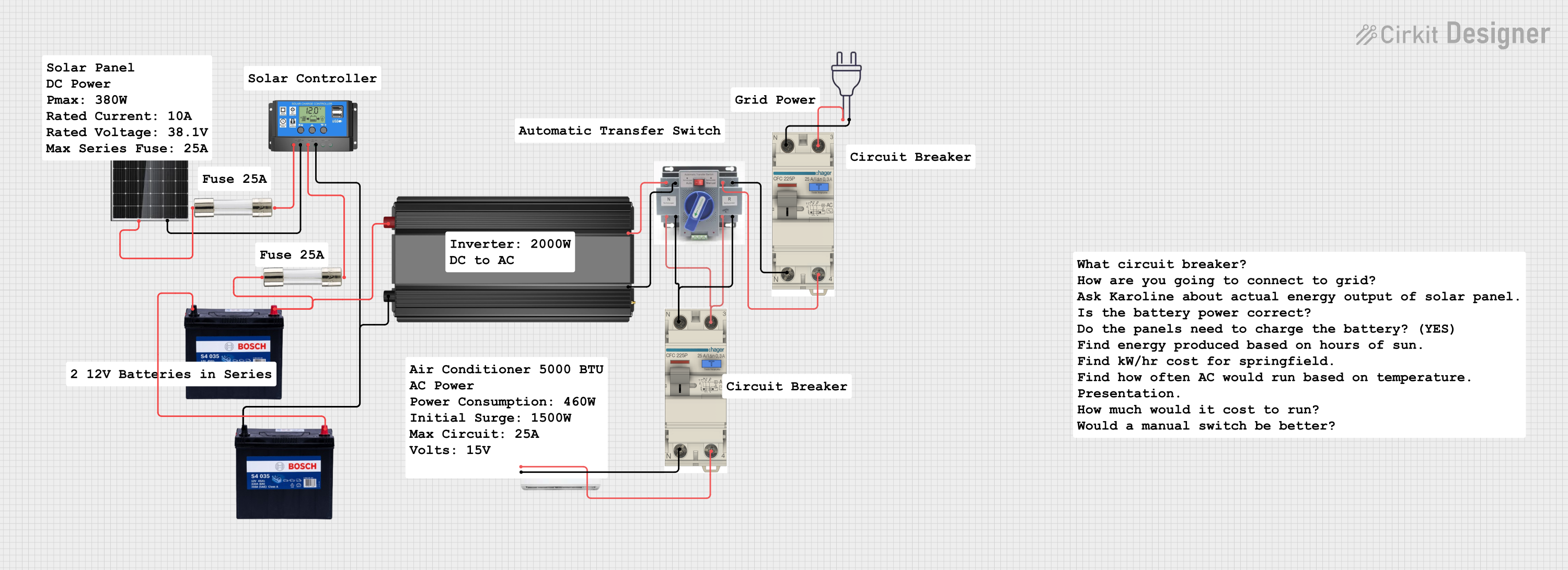
How to Use Solar charge: Examples, Pinouts, and Specs

 Design with Solar charge in Cirkit Designer
Design with Solar charge in Cirkit DesignerIntroduction
A solar charge controller is an essential component in solar power systems. It regulates the voltage and current coming from solar panels to prevent overcharging of batteries, ensuring efficient energy storage and prolonging battery life. By managing the flow of energy, it protects batteries from damage and enhances the overall performance of the solar power system.
Explore Projects Built with Solar charge

 Open Project in Cirkit Designer
Open Project in Cirkit Designer
 Open Project in Cirkit Designer
Open Project in Cirkit Designer
 Open Project in Cirkit Designer
Open Project in Cirkit Designer
 Open Project in Cirkit Designer
Open Project in Cirkit DesignerExplore Projects Built with Solar charge

 Open Project in Cirkit Designer
Open Project in Cirkit Designer
 Open Project in Cirkit Designer
Open Project in Cirkit Designer
 Open Project in Cirkit Designer
Open Project in Cirkit Designer
 Open Project in Cirkit Designer
Open Project in Cirkit DesignerCommon Applications and Use Cases
- Off-grid solar power systems
- Solar-powered lighting systems
- Solar water pumping systems
- Recreational vehicles (RVs) and boats with solar setups
- Backup power systems with battery storage
Technical Specifications
Below are the general technical specifications for a typical solar charge controller. Always refer to the specific datasheet for your model.
Key Technical Details
- Input Voltage Range: 12V/24V auto-detect (common models)
- Maximum Input Current: 10A, 20A, 30A, or higher (depending on the model)
- Battery Voltage: 12V/24V
- Charging Technology: Pulse Width Modulation (PWM) or Maximum Power Point Tracking (MPPT)
- Operating Temperature: -20°C to +60°C
- Efficiency: Up to 98% (MPPT models)
- Protection Features: Overcharge, over-discharge, short circuit, and reverse polarity protection
Pin Configuration and Descriptions
The solar charge controller typically has the following terminals:
| Pin/Terminal | Label | Description |
|---|---|---|
| 1 | Solar Panel (+) | Positive input terminal for the solar panel |
| 2 | Solar Panel (-) | Negative input terminal for the solar panel |
| 3 | Battery (+) | Positive terminal for connecting the battery |
| 4 | Battery (-) | Negative terminal for connecting the battery |
| 5 | Load (+) | Positive terminal for connecting the DC load (e.g., lights, appliances) |
| 6 | Load (-) | Negative terminal for connecting the DC load |
Usage Instructions
How to Use the Component in a Circuit
- Connect the Battery: Always connect the battery to the charge controller first. Match the positive (+) and negative (-) terminals of the battery to the corresponding terminals on the controller.
- Connect the Solar Panel: After the battery is connected, attach the solar panel to the controller. Ensure the polarity is correct.
- Connect the Load: If you are powering DC devices directly, connect the load to the designated terminals on the controller.
- Power On: Once all connections are secure, the controller will automatically detect the system voltage and begin operation.
Important Considerations and Best Practices
- Battery First: Always connect the battery before the solar panel to avoid damaging the controller.
- Correct Polarity: Double-check all connections to ensure the correct polarity. Reverse polarity can damage the controller.
- Use Proper Wire Gauge: Use wires with an appropriate gauge to handle the current without overheating.
- Avoid Overloading: Do not exceed the rated current or voltage of the controller.
- Ventilation: Install the controller in a well-ventilated area to prevent overheating.
- Firmware Updates: If applicable, check for firmware updates from the manufacturer to ensure optimal performance.
Example: Connecting to an Arduino UNO
If you want to monitor the battery voltage using an Arduino UNO, you can connect the battery terminals to an analog input pin on the Arduino through a voltage divider circuit. Below is an example code snippet:
// Example code to monitor battery voltage using Arduino UNO
// Ensure the voltage divider reduces the battery voltage to below 5V for safe input
const int batteryPin = A0; // Analog pin connected to the voltage divider
const float voltageDividerRatio = 5.7; // Adjust based on your resistor values
void setup() {
Serial.begin(9600); // Initialize serial communication
}
void loop() {
int rawValue = analogRead(batteryPin); // Read the analog value
float batteryVoltage = (rawValue * 5.0 / 1023.0) * voltageDividerRatio;
// Print the battery voltage to the Serial Monitor
Serial.print("Battery Voltage: ");
Serial.print(batteryVoltage);
Serial.println(" V");
delay(1000); // Wait for 1 second before the next reading
}
Note: Use appropriate resistors in the voltage divider to ensure the input voltage to the Arduino does not exceed 5V.
Troubleshooting and FAQs
Common Issues and Solutions
Controller Not Powering On
- Cause: Battery not connected or insufficient voltage.
- Solution: Ensure the battery is properly connected and has sufficient charge.
No Charging from Solar Panel
- Cause: Incorrect wiring or insufficient sunlight.
- Solution: Verify the solar panel connections and ensure it is exposed to direct sunlight.
Load Not Powering On
- Cause: Overload or incorrect connection.
- Solution: Check the load rating and connections. Reset the controller if necessary.
Overheating
- Cause: Poor ventilation or excessive current.
- Solution: Install the controller in a well-ventilated area and ensure the current does not exceed the rated limit.
FAQs
Q: Can I use the controller with a 48V system?
- A: Only if the controller supports 48V systems. Check the specifications before use.
Q: What is the difference between PWM and MPPT controllers?
- A: PWM controllers are simpler and less expensive but less efficient. MPPT controllers maximize power extraction from the solar panel, especially in varying sunlight conditions.
Q: Can I connect multiple solar panels to the controller?
- A: Yes, but ensure the combined voltage and current do not exceed the controller's ratings.
Q: How do I know if the battery is fully charged?
- A: Most controllers have an LED indicator or display to show the battery status.
By following this documentation, you can effectively use a solar charge controller to optimize your solar power system. Always refer to the manufacturer's datasheet for specific details about your model.